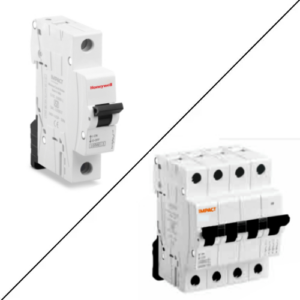Why Buy MCB | MCB Switch – Miniature Circuit Breaker?
Welcome to our comprehensive category dedicated to Miniature Circuit Breakers (MCBs), the unsung heroes of electrical safety. In this section, we delve into the fundamentals of MCBs, exploring their functionality, applications, advantages over traditional fuses, tripping curves, ampere ratings, and breaking capacities. Get ready to empower your understanding of electrical systems and fortify your spaces with the reliability and efficiency that MCBs bring.
What is MCB?
MCB stands for Miniature Circuit Breaker. It’s a type of electrical switch designed to protect electrical circuits from overloads and short circuits. MCBs automatically interrupt the flow of electricity when they detect an abnormal condition in the circuit, such as excess current. They are commonly used in residential, commercial, and industrial electrical installations to protect wiring, appliances, and other electrical devices. MCBs come in various sizes and ratings to suit different applications and are typically installed in distribution boards or consumer units. They offer advantages such as convenience, reliability, and improved safety compared to traditional fuses.
How Does MCB Work?
MCBs operate based on the principles of electromagnetism and thermal effects. When an overcurrent or short circuit occurs, the internal components, including the bimetallic strip and electromagnetic coil, respond swiftly. The bimetallic strip bends, triggering the mechanical tripping mechanism, while the electromagnetic coil generates a magnetic field for rapid disconnection. This coordinated response ensures the protection of connected devices and prevents potential electrical hazards.
Uses of an MCB : –
- Overload Protection: MCBs are designed to automatically trip and disconnect the circuit when there is an overload of current flowing through it. This protects the circuit and connected devices from overheating and potential damage.
- Short Circuit Protection: MCBs also provide protection against short circuits, which occur when there is an unintended connection between two conductors with very low resistance. In such cases, MCBs quickly trip to prevent damage to the circuit and the connected devices.
- Convenience: MCBs are more convenient than traditional fuses because they can be easily reset after tripping, unlike fuses which need to be replaced.
- Safety: MCBs improve electrical safety by quickly disconnecting the circuit in case of faults, reducing the risk of electric shocks, fires, and other hazards.
- Wide Application: MCBs are commonly used in residential, commercial, and industrial electrical installations to protect circuits and equipment from damage due to overcurrent and short circuits. They are found in distribution boards, switchboards, and control panels.
Overall, MCBs play a crucial role in ensuring the safety and reliability of electrical systems by providing effective protection against electrical faults.
Ampere Ratings in MCB:
MCBs come in various ampere ratings, each designed to handle specific current loads. Let’s break it down with practical examples:
- 6-10A: Suitable for lighting circuits and small appliances like LED bulbs and fans.
- 16A: Commonly found in power outlet circuits for moderate loads, suitable for appliances like laptops and refrigerators.
- 20-32A: Ideal for larger appliances and equipment, such as air conditioners and washing machines.
- 40-63A: Used for power heavy appliances like Hot Tubs, Electric Showers, etc.
- 70A-125A: Geared towards heavy-duty industrial applications with substantial loads, including industrial machinery and large-scale equipment.
Tripping Curve of an MCB:
The tripping curve of an MCB describes its response time to different levels of overcurrent. It helps determine how quickly the MCB will trip (disconnect the circuit) in response to a fault condition. Here are the common types of tripping curves:
- B Curve (General-Purpose): It has a relatively moderate tripping characteristic, meaning it will trip relatively quickly in response to moderate overcurrents. It’s commonly used in residential and light commercial applications.
- C Curve (Commercial): It has a slightly faster tripping characteristic compared to the B curve, making it suitable for protecting circuits with motors, transformers, or other inductive loads.
- D Curve (Industrial): It has a significantly faster tripping characteristic compared to B and C curves, making it suitable for protecting circuits with heavy machinery, large motors, or power distribution networks.
- K Curve (Industrial): The K curve is specifically designed for circuits with high inrush currents, such as those found in certain industrial applications. It has an even faster tripping characteristic compared to the D curve.
- Z Curve: This curve is used for sensitive electronic circuits where even small overcurrents can cause damage. It has the fastest tripping characteristic and is designed to protect delicate electronic equipment.
Breaking Capacity (kA) in MCB:
Breaking capacity, often referred to as interrupting capacity, is a crucial specification for MCBs. It indicates the maximum fault current that the MCB can safely interrupt without sustaining damage. Common breaking capacities include:
- 3-7 kA: Designed to handle moderate fault currents typically encountered in residential and light commercial applications.
- 7-10 kA: Ideal for commercial and industrial settings with moderate fault levels.
- 10-20 kA: Geared towards heavy industrial applications or heavy machinery with high fault levels.
- 20-100kA: Used in critical applications where extremely high fault currents are expected, such as in large industrial facilities or power distribution networks.
Advantages of MCB over Traditional Fuse?
Explore the distinct advantages that position MCBs as superior alternatives to traditional fuses:
- Reusability: MCBs can be reset, eliminating the need for frequent replacements.
- Selective Tripping: MCBs disconnect only the faulty circuit, ensuring uninterrupted operation elsewhere.
- Faster Response: Rapid reaction to overcurrents reduces the risk of damage and enhances overall safety.
- Adjustable Sensitivity: Some MCBs offer flexibility through adjustable sensitivity levels.
 (+91) 7439 448 917
(+91) 7439 448 917 Cash on Delivery Available
Cash on Delivery Available



 Circuit Breakers
Circuit Breakers Power Distribution
Power Distribution Modular Switchboard
Modular Switchboard Wires & Cables
Wires & Cables














































